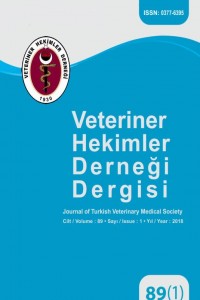Evcil kanatlı hayvan örneklerine uygulanan farklı silikon plastinasyonu protokollerinin etkinliğinin değerlendirilmesi
Abstract
Anatomik
örneklerin hazırlanması ve muhafazası için birçok farklı metot bulunsada,
plastinasyon tekniği ile üretilenler oldukça dayanıklı, doğala özdeş ve insan
sağlığı için zararsız son ürünler olmaktadır. Plastinasyon teknikleri içerisinde
en sık kullanılanı silikon plastinasyonudur. İnsana ait örneklerin yanı sıra
birçok farklı hayvan türü üzerinde de eğitim, araştırma vb. amaçlarla silikon
plastinasyonu tekniği denenmiştir. Fakat kanatlı hayvanlar üzerinde yapılan çalışmalar
oldukça sınırlı kalmıştır. Bu çalışmada 8 adet tavuk, 8 adet evcil ördek ve 8
adet bıldırcın kullanıldı. Örnekler üzerinde silikon plastinasyonunun her bir aşaması
takip edildi ve her aşamadaki parametreler kaydedildi. Bu çalışmanın temel amacı;
evcil kanatlı hayvanlarda silikon plastinasyonu metodunu uygulamaktı. Ayrıca
daha önce kanatlıların plastinasyonunu temel alan detaylı bir çalışma yürütülmemiş
olması sebebiyle, bu türlere özgü bir silikon plastinasyon protokolü geliştirilmesi
de amaçlandı.
Keywords
References
- .
Efficiency evaluation of different silicone plastination protocols applied to domestic avian specimens
Abstract
Although there
are many different methods for the preparation and preservation of anatomic
specimens, pieces produced using the plastination technique are quite durable,
natural identical and harmless final products
for human health. Silicone plastination is the most frequently used
plastination technique. In addition to human specimens, this technique has been
applied to various animal species, for the purpose of education, research and
etc. However, studies focused on avian species are quite limited. In this
study, 8 chickens, 8 domestic ducks and 8 quails were used. Different silicone
plastination steps were followed on the specimens and parameters were recorded
at each step. The main purpose of this study is; to apply the silicone
plastination method in domestic avian species. It was also aimed to develop a
silicone plastination protocol specific for avian species since a detailed
study based on the plastination of birds has not been conducted before.
Keywords
References
- .
Details
| Primary Language | Turkish |
|---|---|
| Journal Section | Research Article |
| Authors | |
| Publication Date | January 15, 2018 |
| Submission Date | November 1, 2017 |
| Acceptance Date | November 10, 2017 |
| Published in Issue | Year 2018 Volume: 89 Issue: 1 |
Veteriner Hekimler Derneği Dergisi (Journal of Turkish Veterinary Medical Society) is an open access publication, and the journal’s publication model is based on Budapest Access Initiative (BOAI) declaration. All published content is licensed under a Creative Commons CC BY-NC 4.0 license, available online and free of charge. Authors retain the copyright of their published work in Veteriner Hekimler Derneği Dergisi (Journal of Turkish Veterinary Medical Society).
Veteriner Hekimler Derneği / Turkish Veterinary Medical Society


